#Legend of Zelda analysis
Explore tagged Tumblr posts
Text
Tw, this might go into death and such.
So I was watching this video about the symbolism of Majora's Mask (which is a really good video I highly suggest you check it out), and halfway through the video I started to realize that on top of Majora's Mask being about grief, I realized that it also kind of covers a certain other kind of grief: your own demise.
Someone has probably already figured this out; I am not the first, but whenever I hear about Majora's Mask being about grieving for someone else, I thought: what if it was also grieving for your own death? All of us at one point of another has thought how we're going to die. Perhaps this game, while not only being a comfort when you're grieving for someone else, but shows us how to accept or face our own demises as well.
I thought about how this pertains to Link. Surely, having already lived through the events of Ocarina of Time, he has already thought about his death. Surely he has already had many near-death experiences on his adventure. I'd like to think that in Majora's Mask, with Link seeing how many people react to their own deaths, kind of gives him a reason to not be afraid of death when his time comes (which we do know does come when he comes back as the Hero's Shade).
This is just one interpretation of Majora's Mask; I know it kind of doesn't make sense considering at the beginning of MM he's looking for his friend so it would make more narratively sense that this would be about grief for a lost friend. We don't know if Link is fearing his own death since really, we are Link, so it could be really anything. Just thought I'd share my thoughts.
#majora's mask#hero of time#hero's shade#legend of zelda analysis#legend of zelda#loz#mm#ladye's random thoughts#tw death
24 notes
·
View notes
Text
Let’s talk about Hyrule’s bestiary, shall we? Tears of the Kingdom, and by association, Breath of the Wild makes this implication that all of Hyrule’s monsters are not a side effect but instead, a deliberate action of Ganondorf and his evil intentions, his malice and gloom. In fact, we quite literally see this in the Tears of the Kingdom trailer, and we see this in an in-game cutscene wherein he commands his monsters to rise up. Which, this isn’t the first time that a Zelda game ever suggests the presence of evil commands the existence of monsters, but I argue that this is a story beat that falls flat and in fact, I think there should be something more to these monsters’ existence; after all, this is a game series that reflects Miyamoto’s youth, mirroring his adventures in the Kyoto countryside, his discovery of that cave and his days-long hesitation to explore the inside of it. The creator and executive producer of many of our beloved Nintendo franchises, Zelda is one of the purest representations of Shigeru Miyamoto, but more importantly, it represents his faith and his relationship with Shintoism. Shintō - the way (tō) of the gods (shin), is a broad, native-based faith that draws focus around remaining in touch with and respecting the kami, that is, gods, the nature spirits, or perhaps the spiritual energy, that are believed to inhabit all things: nature, animals, landscapes...
They are, essentially, the soul of everything.
Miyamoto actually lives close to the Fushima-Inari shrine, a beautiful place of worship at the base of a mountain (also called Inari) dedicated to one of the most familiar kami, Inari, (short for Ine Nari, or Ine ni Naru -- the reaping of rice) who is the god and protector of rice cultivation. Miyamoto has a very personal connection to Inari, believing this nature spirit to be his guardian angel. This shrine is considered to be the head shrine, the big boy among the other thirty-thousand other shrines dedicated to Inari across Japan. The shrine has been around since at least 711AD and is where billions of people have come to pray for a bountiful harvest, prosperity in personal endeavors, the safety and thriving of their family and loved ones, and protection of their home. Worshippers will trek through the approximately eight hundred Senbon Torii, these beautiful Torii gates that are erected in honor and deep thanks by those who have prayed at the shrine and have had their desire or wish come true.
I mention all of this in a post about Hyrule’s monsters because it’s this real-world inspiration that permeates Miyamoto’s video games, informing his game design philosophy. Something particularly iconic about Star Fox 64′s levels, for example, are the many arches you can fly your Arwing underneath and receive health rings or power-ups as a secret bonus reward. This is a direct reference to the Torii gates at the Inari shrine.
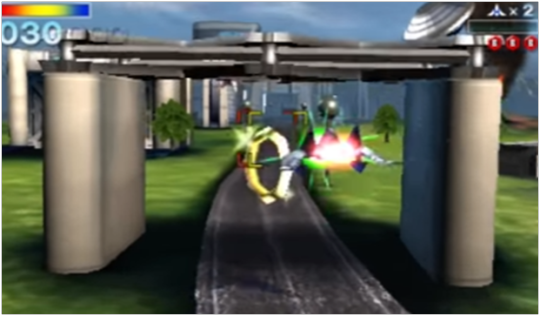
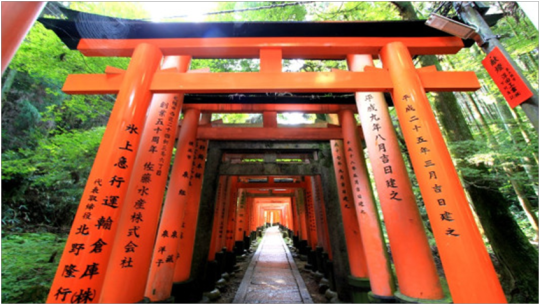
Purity is a very important component when it comes to Shinto rituals, such as kagura, a traditional dance that is meant to establish and maintain the perfect balance between nature, humans, and deities. Impurity, or more specifically, pollution is driven away by these rituals, as Shintoism suggests that it is considered a contamination and obstruction to the flow of life and thus the blessings from the kami.
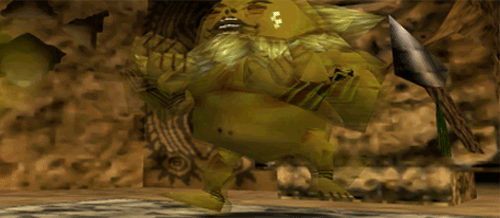
Tôru Ôsawa introduces this concept very, very effectively in Ocarina of Time. Young Link’s adventures across an untainted and pure version of Hyrule introduce us to two nature spirits, two kami, who are integral to the flourishing of their elemental domains. The Great Deku Tree and Lord Jabu-Jabu, both are honored as patron deities amongst their respective tribes. The Great Deku Tree embodies the eternal life, endless youth, and boundless spirit of the mysterious forest and Lord Jabu-Jabu is thought to protect the health and clarity of the water that runs down Zora’s river and crawls through the country, providing Hyrule with fresh drinking water -- the source of life itself.

The early part of Link’s adventure introduces us to these kami. When we begin the game we are introduced to the Great Deku Tree, who has fallen ill after being cursed by Ganondorf, and we are required to travel inside of this great nature spirit and purify him, destroy the monsters, rid our tree-daddy of the impurities inside of him, and cleanse this deity’s soul. When we are almost at the curtain-close of Young Link’s act, we travel inside another kami who is rife with pollution, and as Link, we must heal Lord Jabu-Jabu, who has also become “green around the gills” following a terrible encounter with Ganondorf.
While it’s not subjected to the same anthropomorphization of the other two kami, we know that Death Mountain is alive in its own right. Kaepora Gaebora once whispers to us that the state of the mountain, its mood and its health, can be determined with one glance up at the cloud that crowns Death Mountain’s summit. When Link is a child, he must explore the inside of Death Mountain, purifying one of its many caverns by eliminating the monsters that are infecting it like a virus. Large, dangerous boulders roll down the mountain face and threaten the safety of the sleepy Kakariko Village nestled at the foot of the mountain. These are all symptoms of the natural balance being skewed, of course, brought upon by Ganondorf’s wicked demands not being met.
The beginning of the game doesn’t just introduce us to the controls, pivotal characters and how the world of Hyrule works, but it also establishes this Shinto concept that there is supposed to be a perfect balance between nature, humans, and deities. In fact, this is symbolized in the Spiritual Stones that we collect as we unite and purify forest, water, and fire. While we’re on our journey of healing, we as the player are painted a perfect picture of what a healthy Hyrule looks like – what it should look like.
We know what happens next.
Shintoism doesn’t really promote any commandments for followers to live by in the same ways that a western, Christian-based faith might expect, instead only suggesting that the idea of living a simple and harmonious life with nature and people and is quite simple when adhering to the four affirmations of the Shinto spirit:
Love of nature; nature is sacred, to be close to nature is to be close with the kami
Family and tradition; the family is the primary mechanism by which traditions are preserved
Physical cleanliness; followers of Shinto take baths, wash their hands, and rinse out their mouths often.
Matsuri; to participate in festivals in which worship and honor are given to the kami.
While they aren’t particularly “good” or “evil”, kami are imperfect creatures and there are ways to upset them. Negative actions such as living outside of these four affirmations of the Shinto spirit and thus not living a simple and harmonious life with nature and people, or committing negative actions or evil deeds referred to as “kegare”, (literally meaning “dirtiness”), are an equivalent to committing a sin in the eyes of the kami. While most kami are usually fun-loving, benevolent and quite forgiving, there are kami who make mistakes or are quick to rash actions, and some may actively try to hurt people should they feel disrespected or taken for granted. For instance, if a life is taken without gratitude for this ultimate sacrifice, the soul might experience “urami”—that is, it will hold a grudge. During the spirit’s ongoing rage and pain, it transforms into an aragami: a powerful and evil kami that seeks revenge.
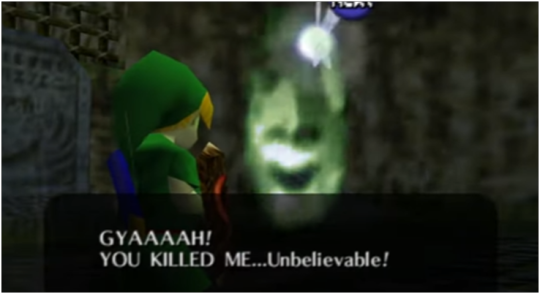
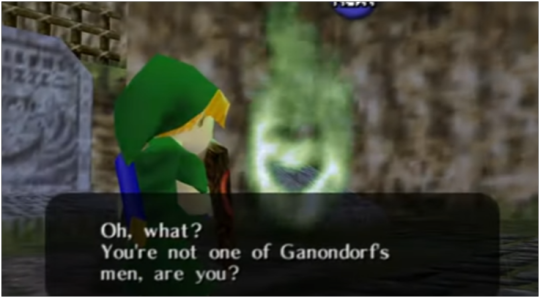
By the time Link wakes up seven years later, Hyrule no longer resembles that perfect picture of harmony with nature, the deities, and humans. There’s a terrible gloom settled into most of the major locations of Hyrule that gives off this desolate, dying feeling to the rest of the country. Everywhere you look, dark clouds hang over the once vibrant skies of Hyrule; the forest is infested with wicked monsters that trap the Kokiri children and their fairies in their homes. Death Mountain is angrier than ever with the ring of clouds blazing with fire as a ferocious dragon now inhabits the volcano. The lake has dried up and Zora’s domain is completely frozen. All the while, a violent and vengeful shadow looms over Kakariko Village.
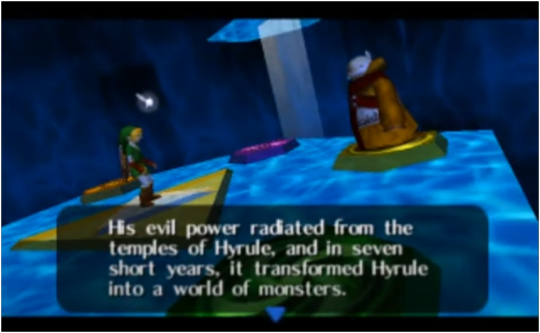
What can be misleading about this part is Rauru stating outright, that Ganondorf’s evil powers radiated from the temples of Hyrule, which kind of suggests what’s happening to the very nature of Hyrule is coming directly from Ganondorf himself as if he’s waving his hand and infecting these temples directly. However, I don’t believe this is the case. This is because of what I’ve established earlier, that due to the mistreatment of Hyrule itself; the balance between nature, humans, and deities has been skewed, the very land as a whole began to sour.
So yes, Ganondorf’s evil power did radiate from the temples, because these were places of worship, sacred temples that belonged to each of the races of Hyrule. Shrines to give thanks to the lands that take care of them, to show appreciation of one another, and to look up to the gods with gratitude. He stole something holy, and thoroughly abused it, disrespecting the Goddesses, abusing the nature of this beautiful country, and caused a horrible rift between the tribes who inhabit Hyrule, and as a result Hyrule rotted. Where gentle nature spirits once roamed, now only horrible monsters remain.
I don’t really believe that many of the monsters that infest the temples and attack Link among his journey are Ganondorf’s servants per se. Certainly, the Iron Knuckles are perhaps one of the only examples of proof of loyalty to Ganondorf’s cause, and even then, with proof of the (probably brainwashed) Gerudo warriors nestled inside of them, I’m not even sure you can call them monsters, anyways.
Why do I think this, then? Well, for starters…
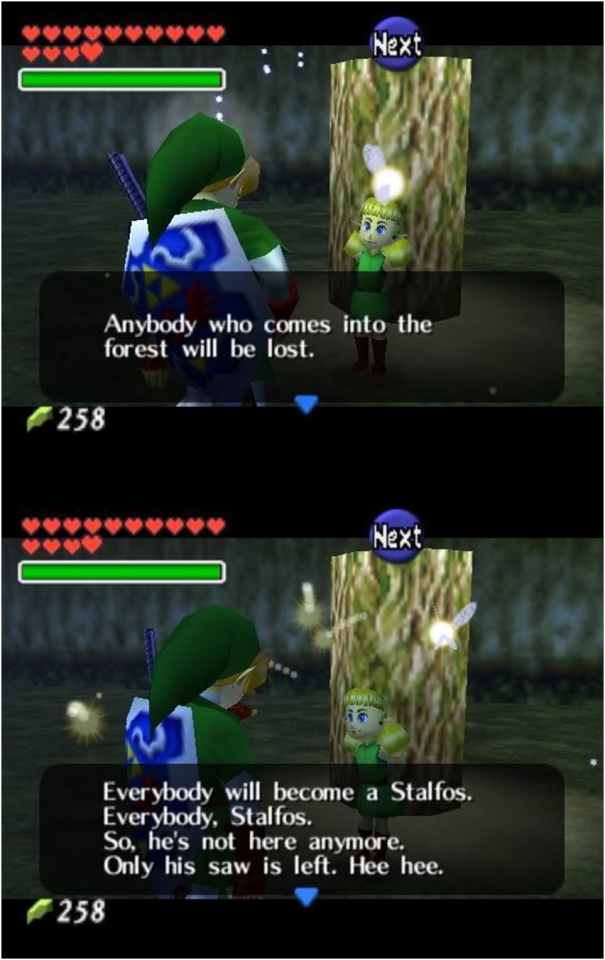
Are we to take Fado’s words to mean that as soon as Grog transformed into a Stalfos, he marched out of the forest and joined up with Ganondorf’s ranks? That’s a cartoonish thought, and while it is possible, it really contradicts with what Fado says specifically: that anybody that comes to the forest will be lost.
Lost is the keyword, there. You see, in a 1999 interview with 64Dream Magazine, Yoshiaki Koizumi, confirms that upon transforming into a Stalfos, Grog instead wandered off to the Forest Temple to live there. He also confirms that this is what happened to the child who stalks around the graveyard in Kakariko, the one who wishes to look scary, just like Dampé. According to Koizumi, five years after Ganondorf obtained the Triforce, the little boy left Kakariko in search of his missing father. Upon entering the Lost Woods, he soon transformed into a Skull Kid, and now fears all adults he encounters.

Even before Ganondorf’s reign of terror, the people of Hyrule were already disrespecting the natural world and its spirits. Taking into considerations the Odd Mushroom that Fado demands back from you upon discovering Grog’s absence because she says it belongs to the forest, or even the Eyeball Frog, who Koizumi confirms in 64Dream Magazine, are often used by those who don’t feel particularly sorry for their sacrifices. Perhaps this is why Stalchildren roam the fields at night, why Peahats often attack any adventurer who wanders too close to their nests, why Skulltulas remain nestled in dark, damp places because even before Ganondorf stole the Triforce, Hyrule was already growing sick from its inhabitants’ greed.
It definitely explains the existence of the Spiders of the Curse…
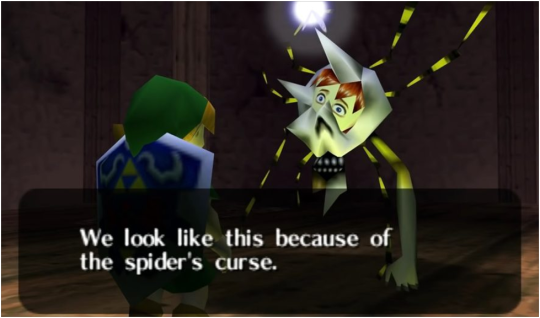
That’s why I feel the idea that Ganondorf purposefully raises the monsters out of thin air to act as his “servants” really takes away some larger nuance and deeper meaning from the Legend of Zelda series, but, hey, that’s just an old boomer’s take.
https://jref.com/articles/shint%C5%8D-the-way-of-the-gods.27/ https://www.bbc.co.uk/religion/religions/shinto/beliefs/kami_1.shtml https://www.bbc.co.uk/religion/religions/shinto/texts/stories_1.shtml#h2 https://www.zeldadungeon.net/the-divinity-of-jabu-jabu-zeldas-kami/ https://femhype.wordpress.com/2016/05/10/japanese-environmentalism-shinto-the-legend-of-zelda/ https://killscreen.com/previously/articles/unmistakable-influence-shintoism-videogame-history/ https://www.zeldadungeon.net/wiki/T%C3%B4ru_%C3%94sawa https://zeldauniverse.net/2011/09/14/immortal-childhood/ http://inari.jp/en/ https://en.wikipedia.org/wiki/Inari_%C5%8Ckami https://en.wikipedia.org/wiki/Shinto https://en.wikipedia.org/wiki/Fushimi_Inari-taisha https://crafttabby.com/explore/nintendo-inari https://www.youtube.com/watch?v=uYPKHbOD_xg https://www.youtube.com/watch?v=GyUcwsjyd8Q https://www.neoseeker.com/the-legend-of-zelda-ocarina-of-time/faqs/162138-zelda-64-script.html https://www.armageddongames.net/archive/index.php/t-61081.html http://forums.legendsalliance.com/topic/17108-list-of-japanese-translations/ https://www.thehyrulejournals.com/what-we-do https://www.learnreligions.com/shinto-worship-traditions-practices-4570821 http://plaza.ufl.edu/sroy12/cgs3066/project2/beliefs.html https://www.patheos.com/library/shinto/beliefs https://archive.org/details/64dream-April-1999-ozidual/64Dream%201999%2004%20%28J%20OCR%29/page/n89/mode/2up https://www.reddit.com/r/truezelda/comments/y13iic/some_minor_lore_details_from_the_developers_of_oot/
#The winds that blew across Hyrule brought something other... :: [HEADCANONS]#Land of Myth :: [OCARINA OF TIME]#Tear Stains :: [TEARS OF THE KINGDOM]#Ocarina of Time analysis#Legend of Zelda analysis#totk spoilers#i guess?
14 notes
·
View notes
Text
a lot of people have already pointed out how totk has a lot of themes of imperialism and generally leans conservative ideologically, but what i think is interesting is how totk subtly redefines what a “researcher” is.
zelda wants to be a researcher in botw, and what this means in the context of botw is largely someone who works with sheikah technology. she wants to figure out ancient sheikah tech, she has an interest in botany and otherwise nature and biology (the whole silent princess and the frog thing), robbie and purah, the two characters who are the closest to us seeing what a researcher in the context of botw is are basically inventors. in totk, however, the main researchers who are presented to us are all historians.
this is an interesting pivot, because in botw zelda is not really interested in history. if anything, the one who’s deeply concerned with history is rhoam, wanting to preserve historical tradition and his uncritical reliance on said tradition and historical precedent is what leads them to their doom. in botw, zelda is narratively opposed to history, if anything, all the ancient tech backfires on them and traditions fail to awaken zelda’s power. zelda’s urge to be a researcher is in wanting to understand the world around her, not just blindly follow ancient plans but rather have agency within them.
totk, however, is obsessed with ancient plans. the only real moment where zelda gets to geek out in totk is her getting all giddy about finding out more about the divine origins of hyrule. all the researchers in the game are concerned with finding out more about the zonai. since all the mentions of ancient sheikah technology are scrubbed from the game purah and robbie read more as strange outliers, the sheikah slate is no longer, now it’s the purah pad, a product of purah rather than something larger. the whole game is literally about following an ancient plan, a plan most characters don’t fully understand as they sign up for it. totk’s main story is built on confusion, on the characters not knowing what’s fully going on but having faith in ancient sages telling them what to do. in botw, following ancient plans you don’t fully understand was the thing that doomed you. in totk, following ancient plans you don’t fully understand is the gimmick.
that juxtaposition between the two games has an ideological through line: botw posits that progress is necessary. mindlessly relying on tradition doesn’t work. prophecies are omens, not instructions. history must be learnt from, not repeated. the ancient sheikah aren’t a group to be emulated, but rather to be learnt from, considering their machinery backfired and the royal family betrayed them. totk, however, is obsessed with the mythical history of hyrule, a time where everything was idyllic until one bad man showed up, a time we must emulate in order to win. i already talked about how the past in totk is zelda’s life pre calamity but better here, but that also plays into the idolisation of that era and its royalty. in botw, even the myth of the first calamity preserves the fact that the yiga clan has origins in the royal’s family persecution of the sheikah, even the time when they successfully held back the calamity is tinged with mistakes that still affect the world ten thousand years later. in totk, ganondorf’s origins are nebulous. nobody provoked him, nobody did anything wrong, he’s just evil because he is.
a lot of right wing ideologies are hinged on preservation, but more than that: the belief in the nebulous mythical past in which everything was better. “make america great again”, the fascist’s idolisation of ancient rome which is represented largely inaccurately, look at any conservative rhetoric and you’ll see people complaining about how things nowadays are ruined or are being ruined, how in the past things were this way and they’re not anymore, which is bad. the belief in the fact that in some past period we were great and are not anymore, and the strive to emulate that past is a trait highly typical of right wing ideologies. and in totk the past as a great era is an idea presented completely uncritically, the narrative is entirely controlled by the game and doesn’t dwell on any of the inconsistencies in this idea.
now, obviously, not every story in which a great ancient era exists is fascist, right wing or conservative. but to me what’s interesting specifically in totk is this shift between the two games: botw is critical of the past. it’s critical of arrogantly repeating history, it’s critical of having blind faith in great relics of the past. totk isn’t. totk idolizes the past, totk tells legends and tells you to believe them without any doubts. botw believes researchers are those who seek to understand the world, innovate it and solve problems without relying on ancient ways. totk believes researchers are those who discover ancient instructions, ancient ways and relay them to great men in the present to be followed. the four mainline regional quests in botw are about discovering four ancient relics that are terrorising the land and fixing the mistakes of the past. the four mainline regional quests in totk are about discovering four ancient legends are true, and receiving instructions from an ancient sage on what to do.
totk is not simply neutral, it is ideologically conservative in stark contrast to botw, because of the things it chooses to leave uncriticised, notably the things botw was very poignant about examining critically. the way totk redefines what is a researcher is indicative of this, indicative of the way it chooses to idolize or present as an unexamined good that which was nuanced in botw. totk isn’t just conservative in the sense that it presents uncritically a “good king” and “evil conquerer”, it goes deeper, it’s notable because botw was starkly opposed to the thematic axioms totk presents.
i just think it’s very interesting that they made a sequel to botw, and completely redefined or otherwise ignored botw’s thematic core.
#totk critical#loz#botw#totk#legend of zelda#tears of the kingdom#breath of the wild#meta#analysis#my hot takes
2K notes
·
View notes
Text
Majora's Mask and what it means to be grown up
(aka my collected analysis of the Legend of Zelda Majora's Mask)
I will say that generally I don't think Termina is purgatory, or a dream, or anything like that. To me, Termina is kind of like a Silent Hill type parallel world, where you face your deepest traumas.
First, the parallels between Majora's Mask, and the child section of Ocarina of Time.
The first dungeon for both games is in a vast wooded area, there are woodland races inhabiting both areas, the Kokiri for Ocarina of Time, and the Deku for Majora's mask. The second dungeon is in a great mountain, inhabited by the Gorons. The third dungeon is in a vast body of water, inhabited by the Zora.
Then, things split. After Jabu Jabu, Link becomes an adult. After Great Bay, there's Ikana Canyon. A land of nothing but Death.
Who caused the death of Ikana? Who else but the king, Igo Du Ikana. Ikana was plunged into disrepair, after Igos started a war with a clan of Ninjas, to receive a powerful artifact, in a great and mysterious temple. Sound familiar? It should, this is exactly what Ganondorf did, after Link was sealed away for seven years. But Ganondorf was successful.
But Ikana isn't completely occupied by the dead, no. Pamela remains, with her father, turned into an undead monster. Much like Sheik, the last Sheikah, who is revealed to be Zelda. And her father? He's never seen, but I'd imagine it would be easy enough for Ganondorf to become king, if the other one was no longer around. From a man, to a corpse.
So, if Ganondorf is a parallel to Igos, and Zelda is a parallel to Pamela, what about Link? He's a little different. I believe that, along with Kafei and Tingle, all three of the transformation masks are a representation of Link, and his feelings towards being forced to grow up.
Tingle is, as we know, a 35 year old man who thinks he's a fairy boy. Similar to how link was a 10 year old boy, who thought he was a fairy boy. I believe Tingle is a reflection of what Link could have been if he never left Kokiri Forest. An adult hylian man, thinking he's a Kokiri.
On the contrary, Kafei is distraught at the idea of becoming a child again. He's weaker, he can't marry his fiancee, and everyone treats him like well, a child, despite his maturity. I believe this is how Link feels after becoming a child again. He used to be a strong adult, and even if he's not as mature as Kafei, he still went through a lot, and knows a lot more about life now. Kafei even reuses Link's model and animations.
There's a reoccurring theme in Ocarina of Time where Link just doesn't belong anywhere he goes. He's an outsider to the other races, because he's a hylian, but he's also an outsider to the hylians, because he was raised as a Kokiri. I think the transformation masks reflect that.
The Deku Butler's Son is what he could have been as a Kokiri. He could have been a happy little boy, living with his father, and his community. But Link and the Deku butler's son both left home to explore, and as far as both the Kokiri and the Deku are concerned, neither came back.
Darmani is what he could have been as a Goron. A powerful hero to the Gorons, celebrated by them for clearing Dodongo's Cavern. A close link between the goron elder, Darunia, and their sons. Both him and Link remain after death, lamenting on their histories as heros.
Mikau is what he could have been as a Zora. Maybe not a cool as hell guitarist, but a husband to Ruto, and Prince of the Zora Who would stop at nothing to keep her happy and safe, like infiltrating a fortress, or climbing inside of a whale.
Even the Fierce Deity is just Link, but back as an adult. As if so much changed so rapidly, he felt like he transformed into something less like himself, and more like a powerful god. He could have continued being strong, and powerful, the defeater of Ganon, but he had to become a child again. He has to stay as a small, and unknown child.
The ages of the masks even match the human life cycle. According to the debug menu (and if you subscribe to the theory that Link and DBS's ages were swapped), DBS is 5, Link is 12, Darmani is 30, Mikau is 78, and, Fierce Deity is 17, likely due to his model being recycled from adult Link's. Link starts the game in the body of a 5 year old, then a 12 year old, then a 30 year old, then a 72 year old, and finally, a God.
We don't exactly know how Link feels. But I can't imagine it would be easy to go from a child, with no concept of death, to be thrust into a position where he's forced to fight and kill an adult man so much stronger than he is. And then everything was just reversed. Like that. As if it never happened. And only Link remembers the impending doom he faced. All he can do is remember Ganondorf's reign. Almost like he's reliving the same few days, again, and again, and again.
251 notes
·
View notes
Text
Something I love about the memory of Zelda and Sonia in the German dub of TotK...

(Translation: And your Link, too, is surely awaiting your return.)
Sonia uses the phrase "dein Link" ("your Link") here, which in German is a common phrase to indicate the belief that someone might have romantic feelings for another person. And the way Pauliner Weiner (Sonia's German VA) delivers this line very much indicates that she is indeed teasing Zelda a little here! Sonia ships Zelink confirmed!!
But wait. There's more!
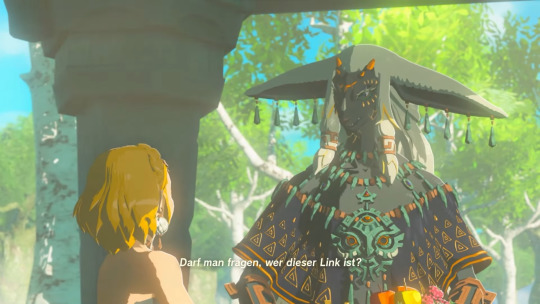
(Translation: May one ask who this Link is?)
Rauru definitely notices this too! His tone, as well as the use of the very specific article "dieser" ("this") indicate as much. If he was simply curious about who Link is in order to follow the conversation, he would more likely use the phrase "Darf ich fragen, wer Link ist?" ("May I ask who Link is?"). He is also teasing Zelda a little here.
Zelda's reply is also very sweet! While her first two lines are nothing special (she is essentially just recapping the events Breath of the Wild, as well as what led up to it), it gets interesting once Rauru reacts to her description, once again in a somewhat teasing manner (indicated by both the delivery and the language of the line):
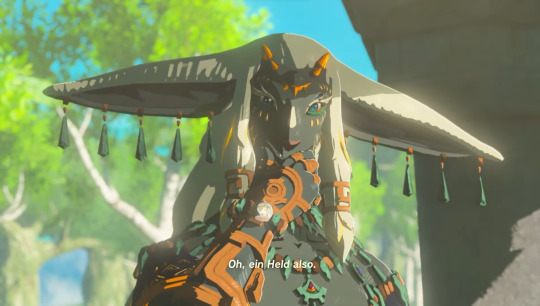
(Translation: Oh, a hero you say.)
To which Zelda replies with:

(Translation: Link is the most steadfast and fearless knight who ever existed.)

(Translation: Yes...)
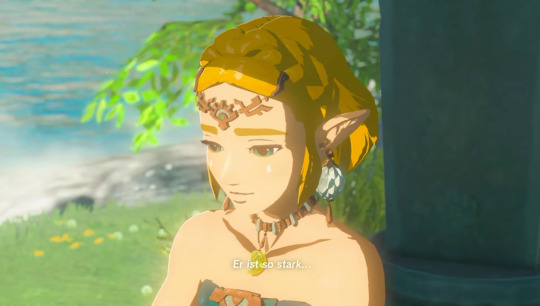
(Translation: He is so strong...)
That last line is pretty much the same in English, but Julia Casper (Zelda's German VA) does an amazing job making it sound like Zelda is not only admiring Link throughout this entire short monologue she is having, but like she is talking more to herself than to Rauru and Sonia, almost like she forgets they're there for a moment because she is thinking about Link. I really loved this little touch!
Also note that Zelda is not explicitly talking about physical strength in the last line (although she might be. It isn't clarified, leaving the interpretation of what kind of strength she is talking about up to the player).
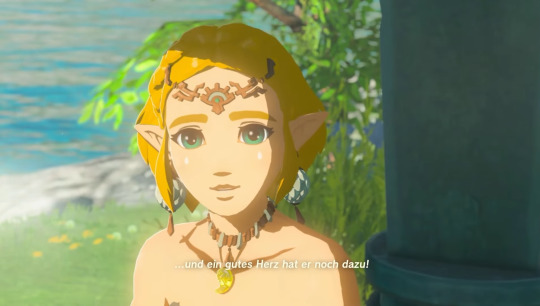
(Translation: ... and on top of it all, he has a good heart!)
This last part seems to be directed at Rauru and Sonia again. But we're still not done!
After Rauru remarks that Zelda seems to think highly of Link and that the way she's talking about her knight makes him want to meet him, Sonia agrees and delivers a final line that, once again, makes it very clear that the two of them are engaging in a little bit of good-mannered teasing in this scene (both from what's actually said here and how Paulina Weiner delivers the line):

(Translation: Chivalrous, and full of gallantry...)
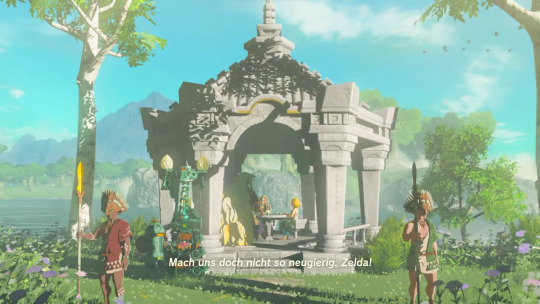
(Translation: Don't make us so curious, Zelda!)
And then they all break out in light-hearted laughter.
All in all, I really love this scene! Huge respect to the German VAs, who did an absolutely stellar job (not just in this scene, but for the game in general - especially Julia Casper!).
#The Legend of Zelda#Tears of the Kingdom#TotK#LoZ#Meta#Legend of Zelda#LoZ Meta#Analysis#LoZ Analysis#German#German dub#Zelink#Zelda#Sonia#Rauru#Currantlee here#Currantlee translating
2K notes
·
View notes
Text
I was watching a video analysing how the Yiga clan were handled in botw and how the person analysing it lamented the fact that Kohga was a joke character who totally destroyed the much more threatening image the yiga clan had all throughout the game. Although I do understand the sentiment (I felt that way for a long time) I’ve come to realise that we might not be viewing it in the right perspective. I ended up writing a comment under that video explaining how I saw things, and realised that maybe it could interest people here too? So here is the fleshed out version of it:
I think part of why they made Kohga extremely goofy compared to a way less goofy clan of literal assassins is to emphasise how even though the clan originally held some understandable beliefs, it has become a cult of personality over the years, and like most cults, the leader is way less charismatic than his followers make him out to be. Indeed, from the outside, it seems absurd how anyone could take Kohga seriously, let alone kill under his command, but from the inside, Kohga is the Beloved Leader That Guides Them Towards Victory, and anyone threatening him deserves to die.
In a way, yiga clan members feel like vulnerable, impressionable people who were enrolled into a cult and given a Big Family and a purpose (and a lethal weapon) by their lovable Master Kohga who wants the best for them… Except if you want to get out, then you’re a filthy traitor who also deserves to die. It’s especially visible when you beat him and they all get personally mad at you for killing him. They didn’t care about Ganon, they didn’t seem to actually understand the bigger picture, they only cared about Kohga.
It also shows how, like the rest of Hyrule, the Yigas are very much disconnected from their own history, seemingly holding on the grudge their ancestors held more as an excuse to continue to enact violence and perpetuate the cult of personality than fighting for a “noble” cause. Only Kohga seems to actually care about Calamity Ganon, and the rest of the yigas seem to be just tools to him. Wether or not he’s actually conscious of what he’s doing is unclear. Is he a fully aware con artist, or is he purely another product of Yiga indoctrination?
So yeah, to me it feels like a parody/critic/mockery of cult dynamics. It shows that this gang of assassins are indeed a real menace, but for seemingly no reason other than “that one lunatic they admire told them to” and “if they go away they get killed”. The reason why the clan was originally created becomes almost anecdotal. Under the current leader, no one is required to actually know what they’re doing, they just need to follow orders.
In the end, I think it is the intention the developers had because cults are a rampant problem in Japan. At the very least, even if it’s not a actually conscious critic, it’s a concept that is much more present in their cultural landscape than ours and that almost certainly influenced how they handled the Yiga clan. Basically, cults are not cool and can even be dangerous both for the public and their members. Cult leaders especially are not cool and often are con artists. Therefore, Kohga couldn’t be badass, he had to be a doofus getting beaten in the most unexceptional way possible.
#botw#breath of the wild#master kohga#yiga clan#kohga#loz#the legend of Zelda#tloz#meta analysis#i purposefully didn’t talk about kohga’s change of heart in AoC because to me this game is not canon#one could argue it proves that Kohga is actually not aware of how catastrophic enabling Ganon would be#but for the sake of keeping it focused on botw I didn’t mention it#cult mention#valictini talks
2K notes
·
View notes
Text
Seeing people talking about the tension between Wild and Warriors, and something just clicked.
In his journey, Wild was forced to work and explore alone. Like, yeah, he temporarily works with Riju, Sidon, Yunobo, and Teba to get to the Divine Beasts, but other than that? He only has himself to depend on, he's only responsible for his own safety and wellbeing. Whereas Warriors fought in a war surrounded by people. He was forced to be responsible for so many lives, but it taught him the importance of teamwork and that he could rely on others.
This shows in how they act in a team, and how they interact with others and the dungeon: Wild is ready to go off and explore everything by himself, leave everyone behind and throw caution to the wind. Because that's what worked for him on his journey, that's how he figured out the world around him and made it through his adventure. But Wars has no experience like this, he only knows teamwork and takes a slower approach. He thinks of plans, and asks questions to get a good idea of what exactly might happen so that he can reduce damage. Because that's probably how he operated in the War, and that's the point of reference he has.
So they're complete opposites in that regard.
Not to mention, Wars is still pissed at Wild for diregarding the plan and beating up Dink. That's the first indication of just how different their experiences were, and who knows? Maybe Warriors expected Wild to know better, considering his past life as a soldier. Maybe that's why he might hold Wild to a higher standard. He probably subconsciously sees Wild as a soldier under his command who's disobeying orders and putting lives at stake, and treating him as such because he knows the danger of when that happens. And part of Wild probably sees Wars as a commander, someone he must obey or fear, though he may not fully realise because of his amnesia. Or maybe he sees Wars as a threat to the freedom his second chance at life has granted him? Someone that could send him back to being that stone cold soldier boy who needs to be perfect?
I don't know, I can't say anything for certain. I'm just rambling vague ideas.
#tloz#linked universe#lu#legend of zelda#sleepy rambles#lu analysis#lu warriors#lu wild#again i have no real proof other than vibes#don't take my word for it
151 notes
·
View notes
Text
HI, CAN I TELL YOU ABOUT THE AKKALA CITADEL?????
Yes? Wonderful. Come, friend, have a seat. I have...a lot to say lol
Eight years later and I am STILL not over how absolutely genius this fortress is, like are you kidding me????? Everything from location to design to its inside defenses is just *chef's kiss* PHENOMINAL, and so because I have no filter, I am going to barf all my thoughts I've had on it in the past many many years.
Before we begin, shoutout to the WONDERFUL video by Zeltik that touches on this a bit and gave me a wonderful basis for my brainrot in the first place. Definitely go and watch it it's fabulous NOW! Let's get into the madness shall we? First let's talk about the location cos OHHHH MY GOSH. This was, hands down, THE best place they could have possibly put a fortress of this magnitude in Hyrule and I am going to tell you why. First of all, allllllll along the northern and northwestern border of Hyrule, there's those massive canyons
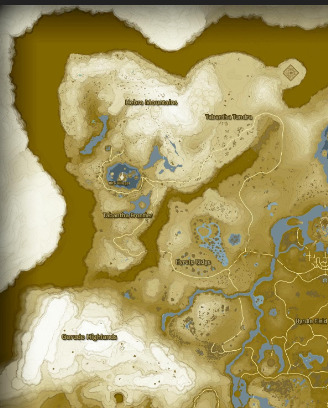
Passing over that in a way that would be effective military-wise is kind of impossible, so it provides a natural defense from invaders from those directions.
If you were to come from the South, you would hit the Gerudo desert and not only have to face the might of the Gerudo military, but also cross this EXPANSIVE, scorching desert before you can even make it to Hyrule field, and by that time, the royal leader could have very easily sent an army to intercept anyone trying to attack, so that's right out.
Which leaves coming from the Faron region next which is okay??? I guess??? but that's a LOT of swamp and forest you have to cross through, AND you go right past the Great Plateau where any army would have been seen and intercepted eventually. This takes us closer to the eastern coast of Hyrule, and you would be hard pressed to try and travel through Necluda, cos just l o o k at all these mountains you'd have to cross:

Horrible. And you probably don't want to go through Zora's Domain cos that's yet another heavily fortified and well prepared city in and of itself (please ask me about this one too I beg of you I love talking about Zora's Domain)
Any military leader with a brain isn't going to go through Death Mountain for obvious reasons, so really, all that leaves is this tiiiiiinnnyyy vulnerable spot in Akkala
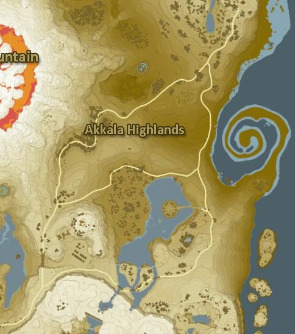
And where did they put the citadel??? Right at the heart of that vulnerable spot >:D Like a boss.
AND SO! if invaders came in from that coastline, they have three options: They can take the path through the Akkala Highlands, they can go through the Torin Wetlands and up to the pass it connects to, or they can take the trail up to the Sokkala Bridges. All of these are TERRIBLE OPTIONS Akkala Highlands path: If they come up this way at the start
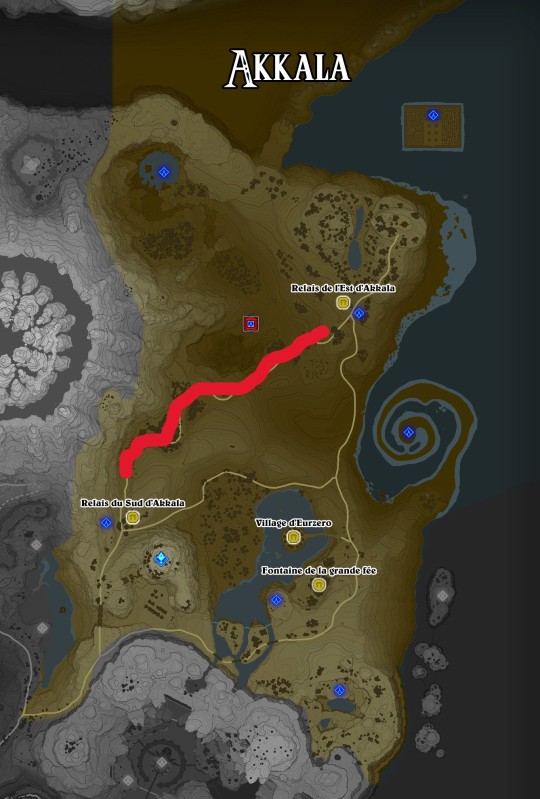
this will work allll the way until they get about here:

once they get here though, you are now not only bottlenecking an entire army meant to invade a kingdom (so probably roughly 1,000-1,300 people), but you're also directly under the shadow of the Akkala Citadel. There are archers there to fire on you, and they had a canon post on that side to potentially fire either at the incoming soldiers or fire at the opposite canyon wall to rain debris and rocks on them.
TERRIBLE for the other army.
And even if some did manage to survive, it would be painfully easy for the infantry at Akkala Citadel to send foot soldiers down below to cut them off.
SO THERE GOES THAT OPTION (and admittedly, I think it's probably the worst of the three)
Next option is to go through the Torin Wetlands and up into that same pass by the Citadel
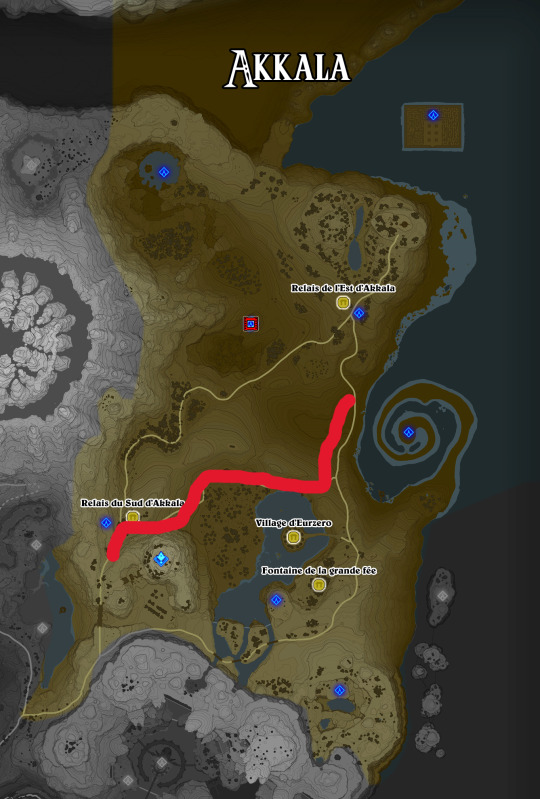
this is ALSO a bad idea because the Torin Wetlands are a DELIGHTFUL tactical advantage for Hyrule. Once you get to that pass, you have the same problems as option one, but now you first have to pass through this wide marshland to get there. This will immediately slow down your army, and if that wasn't bad enough it's also in clear freakin view of the citadel and so they would be able to send their entire militia of archers and potentially even cannoneers to fire on the advancing army and take a bunch of them out before they could even make it to that pass.
So a smart general may say the best option is to go around the long way.

now this eliminates the pass and also slowing down at the marsh, and you could even make it almost all the way to the citadel without hardly any losses probably BUT! The first hurdle is those bridges. Wonderful for Hyrule, terrible for the opposing army. The three Sokkala bridges are SMALL, even smaller than the pass an army would have to go through with the other two options. This military leader would basically have to send their soldiers single file unless they have a way to expand the bridges to make them wider (which, admittedly, could be possible with a bit of foresight, but for now for simplicity's sake let's just assume they didn't think that far ahead).
This brings in an EXTREMELY slowly advancing army right to the heart of the Akkala Citadel's battery.

There are three locations with canons we see in BOTW that cover pretty much the entire open area the opposing army would come in on. And when you look at the amount of space each post covered

There is not a SINGLE spot in that valley a cannoneer couldn't easily reach. And, of course they would continue to have archers to pick off individual soldiers as well.
And if SOMEHOW
BY SOME MIRACLE
enough soldiers make it through that hell to be enough of a problem, there are plenty more soldiers in the citadel to cut them off as they come up the hill AND IF THAT'S NOT ENOUGH! there was this:
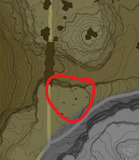
by the time we get to botw, it has been destroyed, but that is ANOTHER smaller stronghold that was probably pretty well manned in and of itself.
AND WHAT'S MORE

There's even this long cliff road with very little room to operate, so it would be extremely easy for the citadel to send over some soldiers to post up there and cut off anyone who tried to make it past. And with so little room to operate, it would not go well.
Ain't NOTHING getting past the Akkala Citadel, guys.
And that isn't even touching on the fact that the whole thing is build of solid stone??? And carved into a mountain??? The entire reason it fell in the first place was because the Guardians had enough of fire power to destroy the citadel that they had never seen before (also they could climb walls but that's a side note). This implies that no one in Hyrule or the neighbouring kingdoms had even CLOSE to that level of destructive power, so to try and raze it to the ground would have been impossible.
AND!! it was the most heavily fortified fortress in Hyrule second to the castle itself, and to most likely their military personnel would have been equal too, if not slightly more than even Hyrule Castle. That's A LOT of people!! With most likely endless support and resources from the castle and villages nearby as well.
It was placed geniously, it had impenetrable defense, it had a potentially endless supply of resources and people to use said resources, it was just
argjfbdkjgbks You guys don't understand how much I THINK about this place aghhhhhhhhhh
#akkala#akkala citadel#rant post#loz botw#breath of the wild#botw lore#legend of zelda: breath of the wild#legend of zelda#Nico's Zelda Location Analysis
195 notes
·
View notes
Text
Answers to the common questions of “Why didn’t Zelda retain dragon features?” and “Why did Link’s arm revert to normal?”
I’ve been dying to do some analysis posts since TotK came out, and after seeing a lot of people complain about the above, I decided my first should be related to the endgame.
So, I’ve seen a lot of posts where people seem to misunderstand what was going on when Zelda changed back into a Hylian, and why Link’s arm returned to normal. Many write this off as simply plot convenience, and while it’s true that Nintendo wouldn’t want to leave the main characters of one of their most popular titles with permanent changes, I’m here to try my best to explain the actual reason these things happened the way they did, because whether you noticed it or not, there is plot relevance to this reversion.
Draconification is permanent.
This is an indisputable fact.
And while I have seen people criticizing the way Zelda changed back, the fact is she swallowed the stone knowing that she never would.
“I’ll be forever changed…”
Her cry for Link to find her was not for her sake. She wasn’t depending on him to find the key to changing her back. Nay, the only reason she desperately prayed for him to find her was so that he could get the Master Sword, which—ignoring game mechanics that would allow you to beat Ganondorf with literally any weapon with the right damage/durability ratio—canonically is the only thing that can hurt him.
When Zelda changed back, it was almost entirely thanks to Sonia. That’s right!
…Let’s take a second to recall this scene in which Rauru decimated the horde of Molduga.
We see Sonia extend her hand and then gesture for Zelda to do the same.
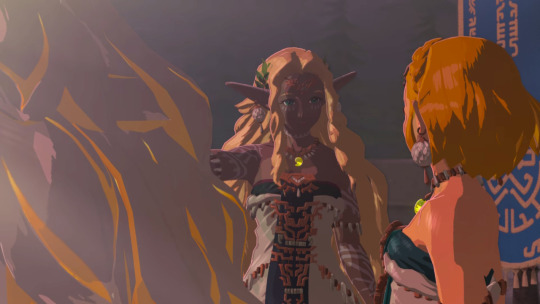
Here they’re extending their own power to amplify Rauru’s counterattack, even beyond the already-massive boost the Secret Stone provides.
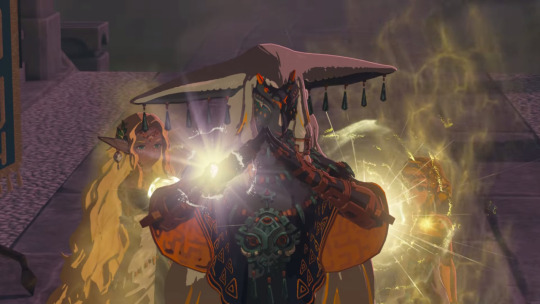
In the final scene when Link finds himself hovering over the sleeping Light Dragon amongst a dream-like atmosphere, it’s really quite telling that Sonia is the first to rest her hand over Link’s, then followed by Rauru.

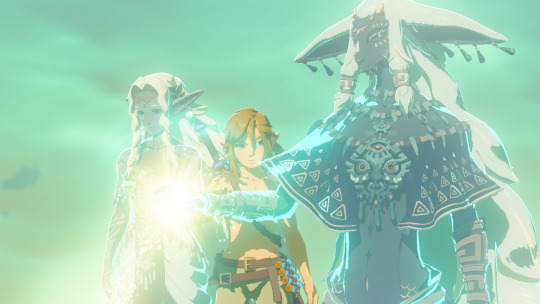
This time Rauru is fulfilling the role of amplifying Sonia’s power over time. Not just that, but adding it on top of the time manipulation that Zelda gave to Link at the beginning of the game.
That’s what’s happening here. This is immensely powerful, triple amplified time magic!
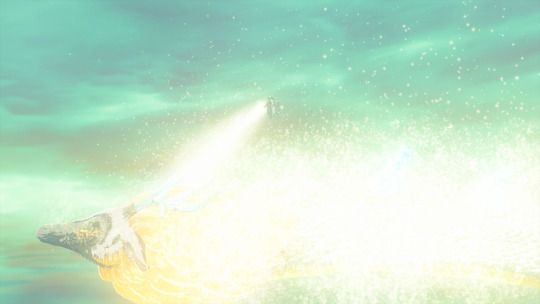
The change from dragon to Hylian wasn’t a transformation in the same sense that it was when Zelda changed from Hylian to dragon. I know that’s a confusing sentence, but consider the basis of Sonia’s time magic is recalling things as they once were.
Zelda didn’t retain dragon features because, through the power of time reversal, she was never a dragon to begin with.
This is the also the reason the Secret Stone reappeared on her necklace.
This is ALSO the reason Link’s arm reverted to its natural state before he was affected by the gloom.
And before y’all come at me with “well, why didn’t Rauru do that in the first place instead of giving his arm to Link?” Simple; Sonia wasn’t there. Even spirits aren’t omnipotent… in Hyrule. (Probably.)
The point is, this was essentially a lucky break for Zelda and Link, because if Sonia (and therefore Zelda, by inheritance) didn’t have time magic, there would have been no way to undo the Draconification. It would have been every bit as permanent as Hyrule legends and history says it is, and Zelda would be gone forever.
In fact, it’s likely it was a shot in the dark even on Sonia and Rauru’s part, considering there was no prior knowledge of reversing time on a dragon, let alone a person. It was a glorious blend of the convenience of Sonia’s time magic, and luck that it worked out the way they (“they” being all characters involved) wanted.
Anyways, to wrap this up, Draconification is indeed permanent, unless you have the number one badass-master-of-time-manipulation Queen Sonia on your side. Then you can probably undo anything. :)
#the legend of Zelda#tears of the kingdom#TotK#totk spoilers#Zelda#Link#Rauru#Sonia#draconification#I haven’t done an analysis post in YEARS#I forgot how much fun it is to write these out#honestly tho if you still wanna hc Zelda with horns and a tail that’s fine#I’m not a fan personally#but that’s just me!#I just wanted to put this explanation out there
1K notes
·
View notes
Text
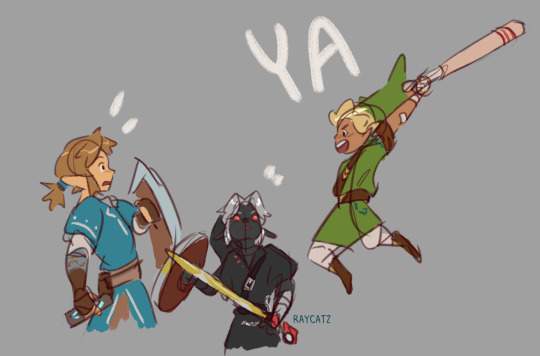
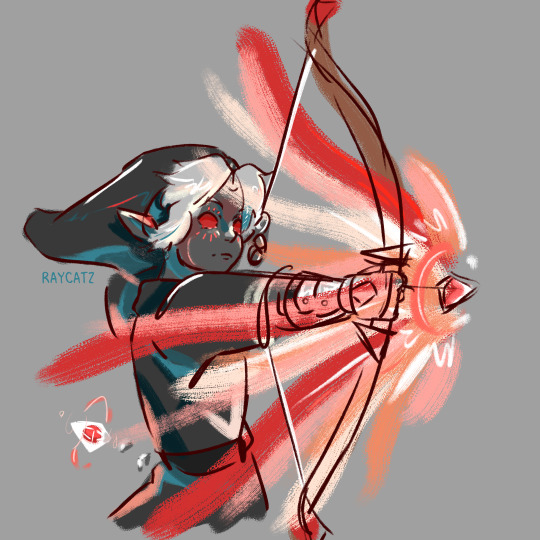
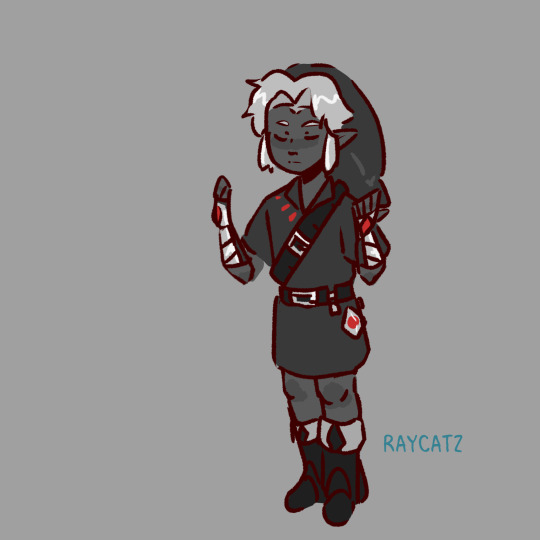
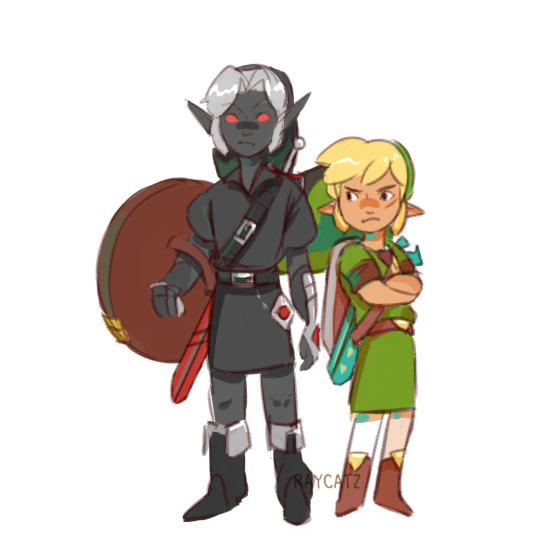
Toon Link is aiming through his skull.
I main as Young Link and Toon Link in ssbu and thought it might be fun to tweak their designs a bit based on the alt costumes I wear and how I play. Their names are Zip and Zop (interchangeably) with botw Link as Zap.
#ssbu#super smash bros ultimate#loz#the legend of zelda#loz fanart#zip zap zop#052823#012022#I have a handful of drawings of these guys to share so I'm going to be doing that over the next few days! (ideally)#insta's seen the last image years ago but it's a first for tumblr#this is not a links meet btw. there will be no longform comic or in-depth ssbu lore or gameplay analysis 'xD#buuut I do have a few short comic ideas for silly things I've encountered in game#I don't know if I'll get around to them because there are so many other things I want to draw! but they're fun to imagine 0v0#I'm not very good at ssbu BUT! I have fun running around as Link and bopping people!!! >:D#the lil guys!#almost won the marching band retreat ssbu game as toon link and then down-aired off the side of the stage 😔
333 notes
·
View notes
Text
Echoes of Wisdom: Timeline Placement

First, we need to remember that the Zelda timeline was updated in 2017 in the Hyrule Encyclopedia. With that update, the Links that are the "same" in each game were updated. The Hyrule Hystoria timeline many are familiar with is from 2011.
Here we can see: ALTTP/LA = 1 Link OoS/OoA = 1 Link ALBW/TFH = 1 Link

Maps: Close to each other but not exact. Very close to EoW and I've seen quite a few posts of similarities floating around so I'll move on. ALBW has a statue in the field or rocks while ALTTP doesn't, for example. OoA/OoS maps not relevant.

Ganon's similarities across the existing games to EoW are pretty easy to see. He's got elements of all of them.

Next up is Zelda:

ALTTP and ALBW designs are very similar to each other, but not exact. Oracles Zelda also has some similarities, but stands out a bit more.

Now look at all these similarities! At first you'd assume she's the same Zelda as ALTTP or ALBW, but that pesky purple girdle? girl-loincloth? Anyway, that's on OoA/S Zelda. Once again, her starting outfit is a mix of all three games.
Where does that leave us? With a high chance that Echoes of Wisdom is a new Link and Zelda, sitting somewhere before or after Oracle of Seasons/Ages.

#Echoes of Wisdom#eow#The Legend of Zelda#Loz#Zelda#legend of zelda#Nintendo Direct#timeline#zelda timeline#eow theory#loz analysis#breannasfluff
181 notes
·
View notes
Text
I was talking to my friends about Ganondorf's horsey and I started noticing that the horse he rides in Twilight Princess looks like it is not... exactly... alive. I've already touched on how I believe his horse has died sometime between the seven years Link was asleep in Ocarina of Time. So let's rewind and head down the "child timeline" instead.
We know that Zant at least had the power to reanimate the dead. Could it be that the Twili-inspired armor this steed is wearing is what keeps it reanimated? We know that Stallord only comes back to life once its been stabbed in the head with one of Zant's wicked swords... So can the armor it wears be keeping it animated?

I mean, Ganondorf is slowed down by Midna, but we see him suddenly transport outside almost immediately after Hyrule Castle falls, already on his horse, standing there triumphantly. We don't see him run in, escaping the fallout. And then, upon defeating him in horseback combat, the horse finally gives in and falls. When the dust cloud settles, it's gone. Ganondorf is noticeably alone again.

Which, I could totally understand the game saving resources for the final intense battle.
...Except that the game continuously makes sure to remind you that Epona (and Zelda) are still present as spectators in this final fight, even though they don't really. Have to be?


We can see that the horse is taking real breaths in the concept art, not to mention it has a colored eye and is opaque in color and shape, unlike the phantom Ganons that follow Ganondorf in his seige.

So is it alive? Has his horse followed Ganondorf's banishment into the Twilight Realm and found itself warped by the forgotten people's forbidden magic?


Or, is this a creature of Zant's brought back to life at "his god"'s command? Fun stuff for me to think about, honestly.
#out of time. :: [out of character]#legend of zelda analysis#shrouded in darkness :: [twilight princess]
4 notes
·
View notes
Text
hey. what if link was so consumed by grief he was angry. cuz a tired link is brilliant, a riddled-with-illness-and-depressed link is even better, but what about a link that is so sick of all of this happening to both zelda and him that he's just FURIOUS.
like he's angry as fuck at how, despite everything they have done to protect hyrule, they're right back where they started. all that effort they put into sealing the calamity, those a hundred years link spent asleep just to be able to live again and those a hundred years zelda spent tearing herself apart just to hold that beast back, all for it to be for nothing. all that effort to dispel the ganon from their time only for ganondorf to appear from another time. it's borderline comical. link has to laugh or he'll cry. he's so tired of this constant fight but he's only tired for himself, when it comes to thinking about how much zelda has suffered and continues to suffer it conjures anger so vivid he feels it in his chest. he's so angry at how much the world continues to punish someone who has done nothing to deserve it, someone who has given her all for the people of this world and more and yet she cannot even feel the grace of peace for longer than a few years. she of all people deserves a break more than anything and he finds himself wishing he'd fallen instead of her.
link finds it hard to process or even care about the goings on in lookout landing after he finally wakes up (again). purah is babbling in his ear about something to do with increasing monster attacks but it's impossible to remain present when his mind is so torn up over zelda, his zelda. gods. she really is gone, isn't she? he doesn't know where she is, doesn't know if she's still breathing, or if he'll ever see those emerald eyes again. it's so much harder this time because last time he didn't even know her—at least not as much as he knows her now. her face was blurry back then and her voice was something so familiar yet so distant, but now he loves her. he knows her inside out, knows her favourite tea to drink in the early mornings and what books she'll pull from the bookcase based on her mood. the sun died that day and so has a part of him.
the air beside him feels so thick with emptiness that he finds himself getting lost in helping the local folks just to fill it, taking up a few errands and joining in with the monster control forces just for someone by his side. weeks pass since her fall and link finds himself stuck in the anger phase of grief. it feels like a disease, he doesn't like how angry he feels but goddess he can't stop feeling this way. it's just so fucking unfair. more often than not link finds himself venturing out of lookout landing deep in the night just to kill. not defeat, not vanquish, but to draw blood in a feeble attempt to quench the burning rage inside his soul. he tears his pathetic excuse of a sword mercilessly through the flesh of unsuspecting bokoblins, slices through the tendons of gloom hands and unleashes the full extent of his fury onto the phantoms of ganondorf's shrivelled form. he yells as he plummets the tip of his sword through the phantom's chest until it disperses into thin wisps of gloom, but it's still not enough. it's never going to be enough. he repeats the same useless task every night yet it does nothing to change anything. he's still angry.
purah's told him about the phenomenas pestering the four corners of hyrule but he can't bring himself to focus on the world just yet, so he goes to mount lanayru. he's waist deep in frozen water with hands clasped around one another when he begins his plea to the goddess. he asks her why zelda was served a fate as cruel as this, and why he seems forever cursed to walk hyrule alone. she doesn't answer. it irritates link, so he repeats himself louder. she still doesn't answer. he's yelling at her now, using the full extent of vocal cords that have barely moved since he awoke, and driving his fists through the spring water in an act of overwhelming frustration. answer me! tell me why we have to endure this! he cries, but the goddess is evermore silent. he chokes out a sob, and then, in a moment of fury, unleashes words undeserving of anyone to hear, not even ganondorf himself. he needs something that will just sit there and take it and right now he's beginning to understand the frustration zelda felt all those years ago when all her efforts went under appreciated. he decides this act is some sort of revenge for how the goddess has ignored them, even if it really isn't her fault; he just needs to feel like he's done anything of use when he's been rendered so powerless. his bitterness only continues to grow the longer she ignores him, until he's exhausted himself from the outburst and stands in the water until his limbs go numb. pathetically quiet, he curses the goddess.
when link learns of zelda's fate after the final tear, he goes missing for weeks. the only noticeable trace of him in the world is the sudden lack of monsters in some areas of hyrule, namely the lynels. the tears had acted as a sort of comfort to know that at least wherever zelda was, she was able to find some sort of comfort or happiness there. the memory of zelda and sonia made him cry hysterically afterwards, of course she still finds a way to speak of him even when they're separated by a millennia or more—but the final tear makes him feel like the air was knocked out of him. he can't even think about it, he tried to ignore zelda's dragon floating aimlessly about the skies for the first few days but the grief became too much. he finds himself cross legged on her snout, braiding blue nightshades amongst silent princesses in her mane, taking comfort in talking to her about the weight of everything on his shoulders. purah's search party is useless when he spends the first week or so constantly by zelda's side, sleeping in amongst the warmth of her locks and offering her buttered apples whenever she perched. "hey, old girl."
seeing zelda this way, knowing she has destroyed herself just so that he may prevail in the fight against the enemy who caused all this suffering.. link vows to become his worst nightmare.
#zelink analysis#hey I'm back from the dead#nice meaty post for you all#had writers block womp womp#legend of zelda#loz link#loz zelda#tears of the kingdom#zelda and link#zelda x link#zelink#link#princess zelda#zelda tears of the kingdom#totk#totk spoilers#loz totk#zelda totk#totk link#the legend of zelda#zelda
598 notes
·
View notes
Text


This is one of those moments where Twilight Princess feels like a modern (for the time) successor to Ocarina of Time. Not in the superficial ways that everyone cites, but by using the camera to flesh the subtext of Link's emotions.
I wish I had screenshots of it, but I'm thinking of the scene in OoT where Link returns to the Sacred Forest Meadow as adult and the camera lingers on the stump where Saria used to be. The camerawork serves an obvious purpose: make sure the player knows Saria is missing. But it also serves to give a glimpse into what Link is thinking. He is dwelling on the fact that his friend is not where he expected her to be. He feels the passage of time, that things which used to be certain no longer are. This is something that would be lost if the camera didn't behave the way it did.
Twilight Princess is a lot more generous than OoT generally when it comes to showing Link's emotions. It may be due to the limit on his facial expressions as a wolf, but it is difficult to parse what he is feeling here at first. But the camera could have focused on Colin the whole time. Instead, after he says his bit, it switches to Link. It reminds the player that Link is there, but it is also telling the player to think about what Link is feeling while he witnesses this.
(actually, my screenshots don't do justice to the scene because after Colin says the first bit, the other characters silently react in their own ways before he finishes and the camera switches to Link)
Midna says something afterward to the effect of "wow, sure sucks that your friends don't even know you're there and won't remember that you saved them." And yeah, maybe that is exactly what Link is thinking. But Midna is also an unreliable narrator, at least in the beginning. She's selfish and looks down on Link for being as kind and selfless as he is. She might be projecting onto him. What if that's what she would feel if she were in Link's position?
I think there's truth in what she says, but I think Link has more going on up there here. He reflecting on how he is watching his timid young friend hold onto hope and comfort a girl who is normally not particularly kind to him. He's proud of Colin, but is upset that he can't show it. Plenty of other times in the game, Link shows his affection for Colin through just a simple smile, which the younger Ordon kids hardly afford him. Link wants to smile at Colin, but even if he could be seen, he would be a terrifying beast to him. But hey, maybe I'm projecting.
#zelda#the legend of zelda#my own#zelda analysis#twilight princess#hero of twilight#twilight princess hd#cooper's captures#zelda colin#zelda beth#wolf link
77 notes
·
View notes
Text
I like the subtle way TotK shows that Link has regained his memories, grown older and more mature. While he is still a goof sometimes, he jokes much less overall (it also better fits the tone of the story that he's less often in a joking mood). TotK Link always handles the Master Sword seriously, while BotW Link does so for a whole of five minutes before proceeding to essentially show off. It's subtle things like that that show how one is a teenage boy (and one with memory loss) and the other a young man who very much knows who he is.

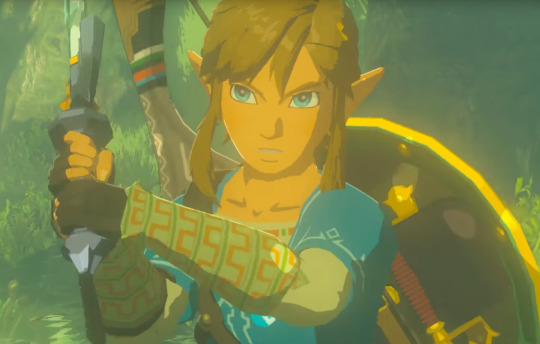
#tears of the kingdom#breath of the wild#botw#totk#loz#tloz#legend of zelda#link#link analysis#botw link#totk link
352 notes
·
View notes
Text
Y’all I’m about to say something that might sound insane, but has Warriors seemed… off? To anyone else?
Like in past updates and comics he’s been very silly goofy. Even when like, awful things are happening, he’s still been kinda smiley or sassy or a bit ridiculous (and i love him for it).
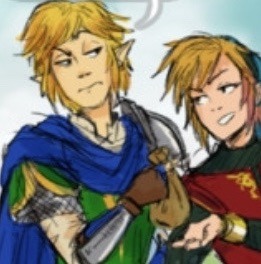
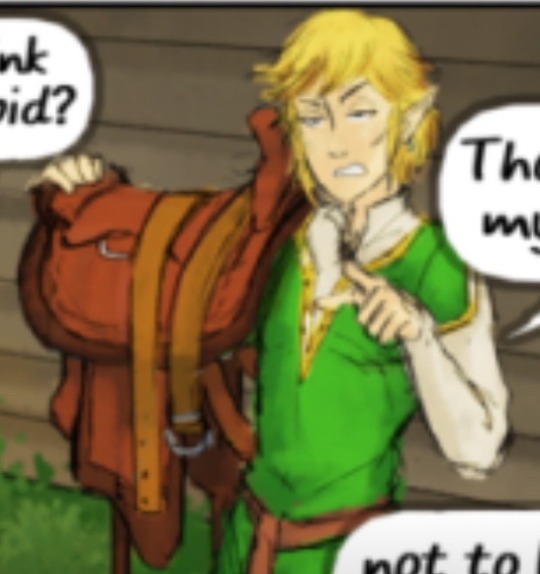

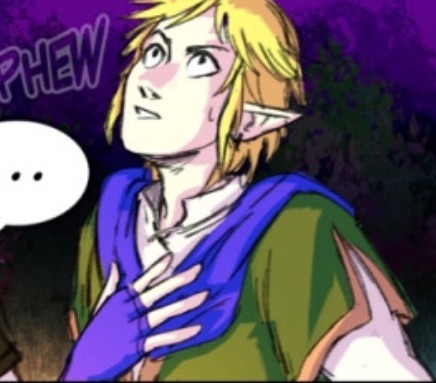
He’s got a strong, loud personality and he’s been very over the top since we met him. But recently in updates he’s seemed kind of down? He’s seemed either really sad or really stressed, he’s been a little snappier than usual, and I know they all just went through something traumatic, but I haven’t noticed any of the others acting off to this extent.
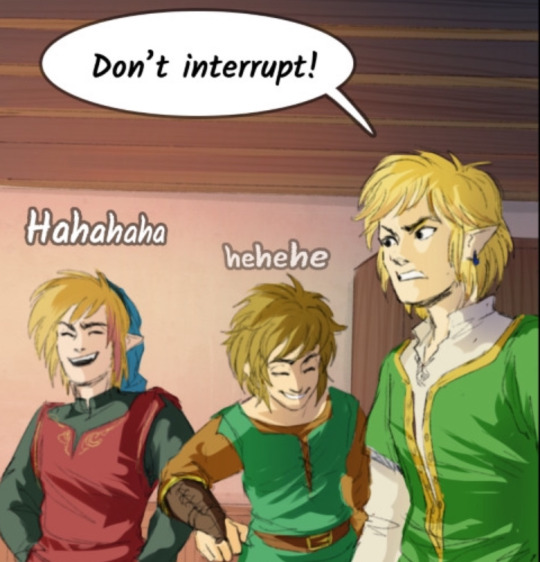


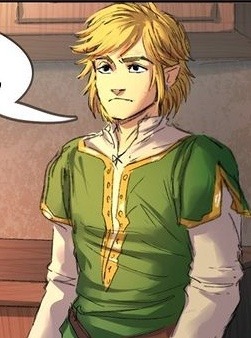
He’s seemed downright SAD in some panels, and annoyed in others. And I’ve also noticed that he seems completely fine in the 2023 monthly arts? Like he was definitely acting normal there.
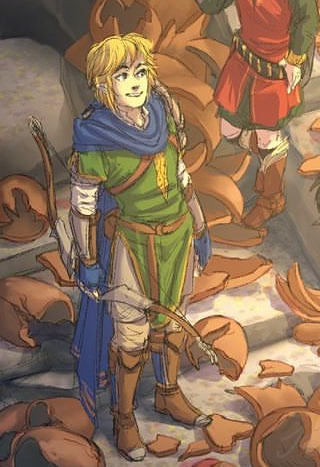
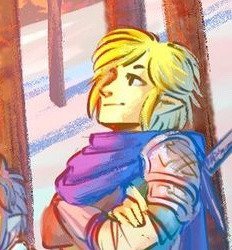
I’m wondering if something else is going on with him, like yes Twilight almost dying was super traumatic, but I wonder if something else has been going on to make him so sad and off lately.
Listen I could just be crazy and looking way too into it, but i noticed this months ago and its been slowly driving me insane
art credit to @linkeduniverse !! :)
#has anyone else noticed this or is it literally just me#i could be loosing my mind dont mind me#the legend of zelda#zelda#linked universe#loz#lu warriors#lu wars#lu#hyrule warriors#linked universe warriors#warriors linked universe#warriors lu#wars lu#character analysis#jes talks
277 notes
·
View notes